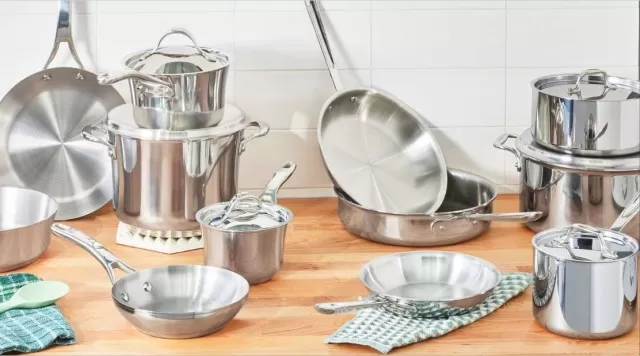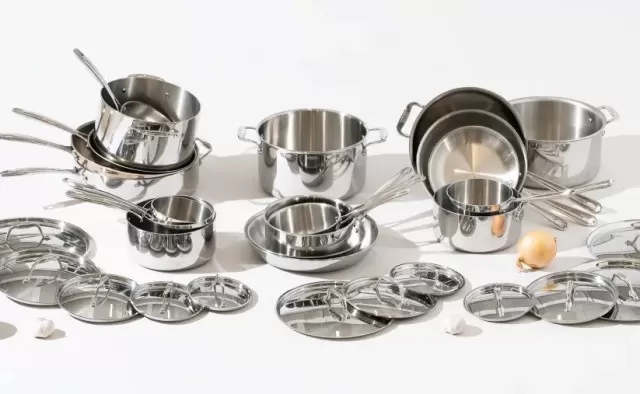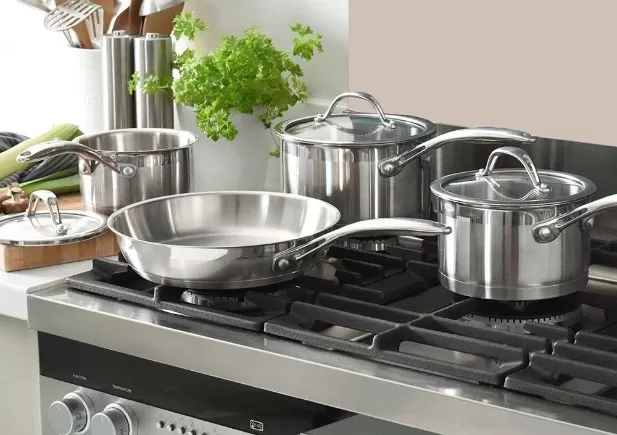Stainless-steel pans are a popular choice among cooks for their numerous advantages, quickly and evenly heats up.
This resilient cookware quickly and evenly heats up, retains heat effectively, and doesn’t require special utensils or complicated maintenance like cast-iron skillets, which need periodic re-seasoning.
Additionally, stainless steel is non-reactive, allowing you to cook a wide range of ingredients without concerns about damaging the surface.
Despite its corrosion and rust resistance, stainless steel is susceptible to burnt-on messes and discoloration over time.
Stains, water spots, and stubborn marks can accumulate with regular use. It’s crucial to understand the proper methods for cleaning stainless-steel pans to maintain their shiny and spot-free finish.
By using common household ingredients and putting in some effort, you can effectively restore the pristine appearance of your stainless-steel pans. Follow these tips to ensure that your cookware retains its brand-new look.
Proper Cleaning and Care for Stainless-Steel Pans

When it comes to cleaning stainless-steel pans, it’s important to follow the manufacturer’s instructions for specific washing guidelines.
While many pans claim to be dishwasher-safe, hand-washing is generally recommended for stainless-steel cookware. Allow the pan to cool down before cleaning to prevent warping.
Avoid using abrasive tools like steel wool or harsh cleaners such as bleach or oven cleaner, as they can cause permanent damage to the surface of your stainless-steel pans.
Here are the steps to effectively clean your stainless-steel pans:.
Scrub the Pan:
For regular cleaning, use hot Soapy Water and a nonabrasive sponge to scrub the stainless-steel pan.
Scrape Stuck-On Food:
If there are any stubborn food bits remaining, fill the pan with soapy water, bring it to a boil, and scrape the residue with a spatula or wooden spoon.
The food should easily come off. Let the pan cool, then wash it as usual.
Boil with Water and baking soda:
For tougher messes like burnt food or oil, a more abrasive approach may be needed.
Baking soda is an inexpensive and effective solution. Add a few spoonfuls of baking soda to the scorched areas of your pan, and add enough water to cover them.
Bring the mixture to a boil and let it simmer until most of the water has evaporated.
Scrub and Wash Again:
Turn off the heat and wait for the pan to cool down.
Use a nonabrasive sponge to scrub away any remaining buildup, and wash the pan in hot, soapy water. If desired, a commercial cleaner like Bar Keepers Friend can be used, following the manufacturer’s instructions.
Remove Discoloration on Stainless-Steel Pans

Once your stainless-steel pans are clean, you may notice rainbow-colored discoloration on the surface caused by overheating.
Here’s how to remove it:.
Wipe with Vinegar: Splash some vinegar onto the discolored area and wipe it with a soft sponge.
Rinse the pan thoroughly and dry it.
Boil with Vinegar and Water: If you’re dealing with white, cloudy residue from hard water, bring a mixture of one part vinegar to three parts water to a boil in the pan.
Allow it to cool, then wash the pan with soap and water.
Sprinkle with Baking Soda: For smaller water spots, dampen a sponge and sprinkle it with baking soda.
Wipe the pan to remove the spots. To prevent water spots in the future, make sure to dry your cookware immediately after washing.
Caring for Stainless-Steel Cookware

Prevention plays a vital role in keeping your stainless-steel pans clean and free from stains.
Remember these tips:.
Allow refrigerated ingredients to come to room temperature before cooking to prevent sticking.
Preheat the pan before adding oil, and wait for the oil to become hot before cooking to avoid food sticking to the surface. When cooking pasta or similar dishes, add salt only after the water has reached boiling point to prevent pitting corrosion, which can lead to small dents in the pan’s bottom.
By following these simple cleaning and care techniques, you can extend the lifespan of your stainless-steel pans and keep them in pristine condition for years to come.
*The information is for reference only.